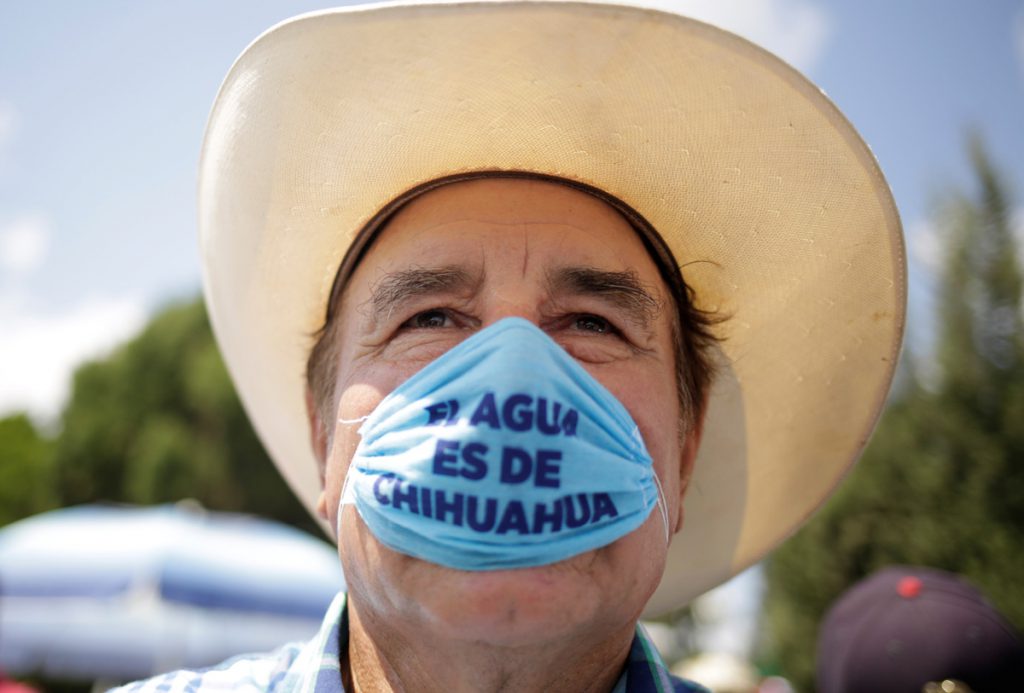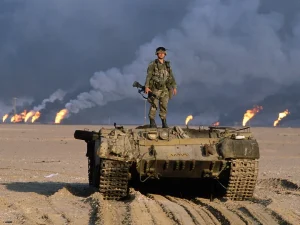Have you ever wondered what you would do without water? Water is indeed life. And without access to clean water, life’s hardships become further amplified. For many people in the US, water is a resource that they take for granted as it reliably flows through our fingers when we open a faucet in the kitchen or bathroom. Despite nearly 71% of the earth covered by water, large segments of people have little to no access to water. Recently, farmers in Chihuahua, Mexico, realized the precarious situation they found themselves in while enduring the drought at the same time that impending water payments were due because of a treaty with the United States that intended to promote water security in both countries. Mexican farmers faced with the harsh reality that they might not have water for their next harvest. The idea of this possibility prompted farmers and other citizens around the state to protest by blocking highways and showing up at dams. Tensions between the Mexican government and its constituents reached an all-time high when a protester was killed on September 8, 2020 by a Mexican national guard. So, how did the fight over water turn deadly?

To understand the severity of the issue, one must first go back to the ratification of the water treaty between the two countries. In 1944 The United States of America and Mexico signed the treaty “Utilization of Waters of the Colorado and Tijuana Rivers and of The Rio Grande”. This treaty was created to ensure the water security of both countries through the sending of water between each country.1 Every year the United States sends nearly 489 billion gallons of water from the Colorado River to their neighbor Mexico. Unfortunately, Chihuahua receives little to no water from this treaty. Most of the water sent by the United States is delivered to bordering states such as Nuevo Leon and Tamaulipas. Moreover, while they receive a small portion of the United States’ water payments, the state of Chihuahua sends more than half of the 114 billion gallons Mexico sends to the US each year. This has burdened the farmers of Chihuahua in recent years as they try to irrigate their own crops.2 Chihuahua is home to the biggest production of nuts and chilies in Mexico. In fact, Chihuahua produced 79,934 metric tons worth of pecans in 2015. This accounted for 65% of all pecan production in Mexico. when one considers that pecan trees require an estimated 34,000 gallons per year, it is easy to see why Chihuahua needs to retain as much water as they can in their dams for their farmers.3

Still, in 2020, Mexico fell behind in its payments to fulfill the requirements of the treaty of 1944. The country reportedly owes 345,600 acre-feet of water which is due by October 24th. This deficit accounts for 88% of what Mexico owes within the five-year quota. The President of Mexico, Andrés Manuel López Obrador, wants to make the payment and is relying heavily on Chihuahua to deliver most of that payment through its dams. As he sees it, it is in the best interest of the country to make the payment, since the United States sends more water to Mexico than Mexico sends back. The Mexican President also fears that President Trump will impose tariffs on Mexican products if Mexico fails to meet the requirements set forth by the treaty.4 However, Chihuahuan farmers know the effect the payment would have on their livelihoods. The transfer of the water Mexico owes to the United States would drastically decrease the water levels within Chihuahua, which would result in an exponential decrease in production as well. Fearing the future implications that the fulfillment of the treaty would have on their farms, Chihuahuan residents decided it was time to take a stand.5
Since the start of the year, Mexicans have been protesting the decision to pay for the treaty with Chihuahua’s limited water resources but the biggest protest came in September. In September, 2,000 farmers marched up to the dam name La Boquilla after hearing that the Mexican government had diverted increments of water to the United States instead of meeting the agreements it had with the farmers.6 Protesters were able to gain control of the dam when they overpowered law enforcement. As the news broke about the protest, the Mexican National Guard was deployed to La Boquilla Dam. Farmers first tried to dialogue and to preserve this resource, but they soon started feeling as though their needs were not being heard and escalating into violence. Confrontations between the two parties became more violent as farmers started setting fire on the dam’s infrastructure and damaging police vehicles in hopes that it would send a message to the government or gain more recognition from the media. Amidst all the commotion of the protest, a national guard shot and killed a woman protester and severely injured her significant other. Jessica Estrella Silva Zamarripa was the daughter of pecan farmers and the mother to three children. She was bravely fighting for her human right to water when she was killed. Her death shed a light on the issue of water distribution and has become a source of motivation from people all over Mexico.7

Meanwhile, President Andrès Manuel Lòpez Obrador attempted to downplay the protests and the severity of the issue. He went on record stating the protests had been staged by his political opposition.8 In a press conference, the President named 17 politicians who he says funded the fake protests. Andrès Manuel Lòpez Obrador has also attempted to gain more support from the Mexican population at large by stating he will request for the United Nations to complete a study to ensure that the United States is actually sending the amount of water that they say they are sending. Moreover, the President of Mexico assured his constituents that he will take matters into his own hands, saying he will personally appeal to the President of the United States to renegotiate the amount that Mexico owes or at least the terms by which that payment is made.9
With low rainfall and a large water debt payment looming, the Mexican government faced a dilemma. On one hand, the Mexican government wanted to keep good diplomatic ties with its neighboring country. Failure to make the payment could potentially result in sanctions on Mexican goods, which would affect more than the agricultural production of Chihuahua. On the other hand, if the payment of the water owed was made, President Andrès Manuel Lòpez Obrador could further alienate the people of Chihuahua. The transfer of the 345,600 acre-feet of water to the United States would leave Chihuahuans unable to water their crops for the following season. The President’s negligence regarding the issues provoked protests all over the State of Chihuahua against the violation of their human rights to preserving their water, their crops, and their lives.
Finally, on October 22, 2020, two days before the deadline for the water payment, Mexico and the United States reached an agreement that would account for the 345,600 acre-feet of water that was owed. The last-minute deal would hand over the rights of Mexico’s share of the water from the Amistad and Falcon dams to the United States. The terms of the agreement would reportedly spare Chihuahua with enough water for the next farming season. The deal would also implement “workgroups to analyze and develop water management tools to provide for increased reliability and predictability in Rio Grande water deliveries to users in the United States and Mexico”.10 While Mexico was able to fulfill the treaty requirements, it came at a huge cost to the country. Ultimately, the potential risk of water insecurity in the state of Chihuahua cost Mexico thousands of dollars worth of infrastructural damage plus the loss of life for one of its citizens, a young mother.
- “Utilization of Waters of the Colorado and Tijuana Rivers and of the Rio Grande” Accessed October 16, 2020, https://www.usbr.gov/lc/region/pao/pdfiles/mextrety.pdf. ↵
- Pamela Constable, “Mexican Farmers Occupy Dam to Stop Water Payments to the United States” Washington Post, https://www.washingtonpost.com/world/the_americas/us-mexico-water-dam-farm-protest/2020/09/13/dddb85e8-f3bb-11ea-999c-67ff7bf6a9d2_story.html, Accessed October 16, 2020. ↵
- Julio López-Díaz, “The Pecan Industry in Chihuahua Mexico: Challenges and Successes,” https://aces.nmsu.edu/ces/pecans/documents/9%20Lopez%20Diaz.pdf. ↵
- Mark Stevenson, “Mexico Struggles with U.S. Water Debt, Suggests U, N, Audit,” September 3, 2020, https://www.pbs.org/newshour/politics/mexico-struggles-with-u-s-water-debt-suggests-u-n-audit, Accessed October 16, 2020. ↵
- Pamela Constable, “Mexican Farmers Occupy Dam to Stop Water Payments to the United States” Washington Post, https://www.washingtonpost.com/world/the_americas/us-mexico-water-dam-farm-protest/2020/09/13/dddb85e8-f3bb-11ea-999c-67ff7bf6a9d2_story.html, Accessed October 16, 2020. ↵
- Mexico News Daily. “National Guard Backs off after Tear Gas Fails to Dislodge Chihuahua Farmers,” September 9, 2020. ↵
- Pamela Constable, “Mexican Farmers Occupy Dam to Stop Water Payments to the United States” Washington Post,https://www.washingtonpost.com/world/the_americas/us-mexico-water-dam-farm-protest/2020/09/13/dddb85e8-f3bb-11ea-999c-67ff7bf6a9d2_story.html, Accessed October 16, 2020. ↵
- Eoin, Wilson, “Mexico’s Water Crisis Heats up as Transfer to US Looms”, https://www.aljazeera.com/news/2020/10/8/mexico-water-crisis-heats-up-as-us-transfer-deadline-looms, Accessed November 2, 2020. ↵
- Patrick McDonnell, “Mexican Water Wars: Dam Seized, Troops Deployed, at Least One Killed in Protests about Sharing with US”, https://www.latimes.com/world-nation/story/2020-09-11/mexican-water-wars-dam-seized-troops-summoned-at-least-one-killed-in-dispute-about-water-sharing-with-u-s September 12, 2020. ↵
- Mark Stevenson, “Mexico Reaches Deal to Pay Water Debt to US”, https://abcnews.go.com/International/wireStory/mexico-reaches-deal-pay-water-debt-us-73768266, Accessed November 9, 2020. ↵



68 comments
Alexis Zepeda
As I read this article, I heavily appreciated the fact that the history of the treaty was mentioned. Personally, I could not help but connect it with a recently discussed concept from my civic engagement class. In the class, my class and I discussed laws, executive orders, etc. that themselves may have just or unjust intentions that can possibly be turned or misconstrued by social institutions for the worse or maybe even the better. Initially, the treaty between the United States and Mexico seemed just because at the treaty’s face-value there seems to be no victims in trying to simply ensure water for the two countries. In regard to the two countries, it seems like a “win-win” situation, if you will. As the article progresses, it is evident how institutions and social structures heavily affected how the treaty the people of Mexico, more specifically, the people of Chihuahua. Furthermore, the brave and courageous protests induced what is called a social change shown by the new agreement reached by Mexico and the United States. Overall, this article inspires me to be more grateful for things many of us take for granted, to stand up to these injustices and to simply do the right thing for all.
Greitin Rodriguez
Resources are a necessity for human life. Especially the need for water. Water is needed for life and for the production of our foods. In the United States, we have the comfort of water and the comfort that it will always be there. But, for other countries they do not have the security; like the United States people have. The Chihuahua Water Crisis is bigger than one could imagine. It is the struggle to have the principle of human life resource. It destroys the people and their connection to the government. With the conflict of needing water to survive, people raised up together to fight for their well-being and for their basic right to have access to water. With this movement, it made people bring a change to the water, to the government, and brought a civil duty that others could follow for there future fights.
Carollann Serafin
Water is something for a long time has been taken for granted. It is sad that Mexico as a whole struggles with receiving useable water. It is even more sad knowing that if no water is available to the people how will they grow their crops or gain any of their income to feed their families. Why is water scarcity still being short and why can it not be made more accessible. As a human with common sense why do we need a form of peace agreement or treaty it is human decency water is needed for us to survive.
Alexander Garcia
This was a very well written article that captivated me until the very end. Not only was the article captivating, but it was also extremely informative because it allowed the audience to truly see how bad of a position Mexico is in as a result of water scarcity. Although article’s like this one are very sad, it is important to recognize that these types of articles are necessary because the public must hear stories that will make them uncomfortable in order to possibly enact change.
Kaylah Garcia
Great work on this topic! The headline of the essay drew me in right away. I believe it’s fantastic that you included the Spanish language, especially given the subject. The loss of life while defending a natural-born right is so tragic. Personally, I think your explanation of the matter was excellent. If anything, I think the font change caused me a little confusion. But I’m just being picky, so there.
Jacqueline Galvan
The water crisis in Chihuahua is one that the world should be educated on. The injustices that the people of Chihuahua have faced in the past and continue to battle should be well known, and this article does an excellent job of bringing the injustices of President Obrador and the Mexican government to light. The mishandling of the treaty is something that gravely needs to be rectified.
Andrew Ponce
This article in particular, struck my attention for the reason that my own grandmother is from Chihuahua, Mexico. Reading this article and realizing the neglection of water transferred from the U.S. to Mexico is extremely high. I personally was unaware of the agreement between the U.S. and Mexico, however with the new realization of water scarcity I want to do my personal best to better appreciate water. Considering it is such a limited resource in other places around the world. Very interesting article!
Melanie Fraire
I was completely unaware of this treaty, I’d never heard about nor did I know such a thing even existed which is terrible considering how big of an impact it would have on the country if the treaty were to fail. Overall, the article was well written and I enjoyed the way it was organized by giving background on the treaty as well as giving a chronological order of events. This article also helped highlight the importance of the treaty and bring attention to the issue considering that I don’t see much coverage on it.
Aaron Astudillo
The issue of water security is one that is often thought about in our current society, but the article was able to shed light on the issue going on in Chihuahua. The concerns presented by its citizens are ones that I was unaware of, and find to be deeply troubled by. The issue of water that is necessary for sustaining all walks of life is one that should not be taken lightly, and the article does an excellent job of describing this concern.
Illeana Molina
It is heartbreaking that Mexico is experiencing this terrible tragedy, and an incredible yet brave individual died to stand up for something as simplistic as water. Every day you see individuals taking the water we have for granted when it isn’t like that everywhere. With this article, we see and feel the hurt people are experiencing as “nearly 71% of the earth is covered by water, large segments of people have little to no access to water.”
It is a basic human need to live, and people worldwide struggle. Water insecurity in Chihuahua cost Mexico thousands of dollars of infrastructural chaos/damage. It has also caused Jessica Estrella Silva Zamarripa, “ the daughter of pecan farmers and the mother to three children. She was bravely fighting for her human right to water when she was killed. It is because of one individual that has paved the way to begin a discussion on water distribution for people all over.